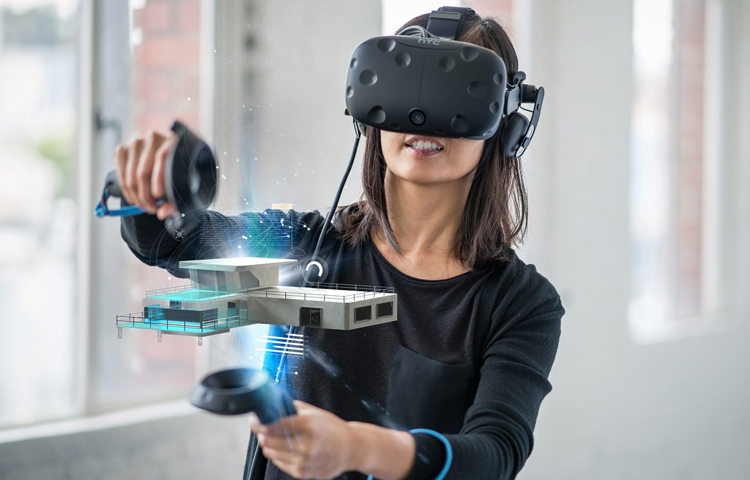

Prefer to listen instead? Here’s the podcast version of this article.
Everyone has his or her own definition of virtual reality or VR—whether it’s fun gaming goggles that plunge you into the ocean next to the creatures with whom you’re swimming or tossing you into the middle of a dodge ball game where you’re ducking and weaving a bombardment of balls.
As its technology improves, VR will become even more sensory oriented and incorporate more than just the visual senses. Imagine technology that can change what we feel body and temperature-wise, and what we smell. The line between the virtual and the reality will blur even more.
Captain Picard’s utterance may have driven this phrase into the mainstream, but nowhere is it more true than with virtual reality. VR really will be able to take you places you’ve never gone before: virtual field trips, travel back in time, space exploration… the possibilities are endless.
The reality of VR, however, is that it has the possibility to do so much more and offers so many more applications—not just for entertainment, but in
the medical, exploration, and other fields, too.
Clearly, this industry has grabbed onto VR and not let go. According to research firm IDC, it predicts that the virtual and augmented reality market will expand from revenues of $9+ billion last year to over $215 billion by 2021— a 118% growth rate that would make VR one of the fastest-growing industries in the world.
Samsung and HTC’s VR headsets sell well now, and the IDC’s data suggest that these and other companies will sell over 81 million headsets annually by 2021. As the headsets’ technology and performance improves, they’ll attract more content developers which will grow the industry even more.
This technology is still in its infancy, but with the advent of 3D televisions and 3D films, it’s growing. If you harken back to the 1992 film The Lawnmower Man, you may remember that it was the first film to show a technology that allowed characters to explore simulated worlds by wearing crash helmet-sized head-mounted displays (HMD).
Nothing changed—much—for 20 years but in 2012, the start-up tech company Oculus developed a less expensive, lighter, clearer head-mounted display. By 2014, Google added Cardboard, a system that turned smartphones into head-mounted displays.
Then came the 360° video known as cinematic virtual reality (CVR). Currently, the New York Times offers a Daily 360 service and, in 2016, commissioned Great Performers: LA Noir, which was a series of CVR shorts. The Sundance Film Festival also introduced a VR strand, and in January 2018, Protozoa Pictures signed a deal for a new three-part VR series about space exploration, called Spheres.
Many believe, though, that it’s still too early to conclude that VR will become a mainstream medium within the film industry, but the possibility is tantalizing.
Google Maps and Google Earth have drawn the world’s boundaries ever closer, but the world they present is still rather flat. What if you could take a VR tour of the Great Wall of China without leaving your living room? Or take a French class to visit the Louvre without spending $3,000 to fly to France? Or show real estate clients five properties many miles apart from your office?
The use of medical cadavers during surgical training is a practice that’s decades old. So is the availability of increasingly lifelike plastic models that approximate all parts of a human body. But imagine VR technology that would enable people to program fully-interactive, accurate specimens that could be “stricken” with a wide variety of ailments treatable only through surgery or, in this case, a VR interface.
Today, VR is used as a tool to provide training for:
Flight simulators are nothing new – but imagine a level that’s even more immersive and realistic and enables pilot trainees to really experience the full range of situations they could encounter during a flight. Users wear headsets instead of sitting in a cockpit; the systems cost significantly less to purchase and maintain than full-size cockpit simulators. They’re also portable, which makes them perfect for providing onsite training in remote locations for those in the military, for example.
NASA astronauts require a minimum of two years of training before they’re qualified to fly in space—and one of the largest aspects of that training involves learning how to work in such a harsh, unforgiving environment. The agency uses a Neutral Buoyancy Lab to train its astronauts for spacewalks, but NASA also uses virtual reality at Houston’s Johnson Space Center.
The VR lab enables astronauts to experience a wide variety of scenarios they might encounter on a mission to space, the space station, the moon, or even Mars. It enables them to safely experiment with various solutions for when things go terribly wrong as well as accustoming them to the realities they’ll encounter in space.
Imagine if you or a loved one suffered from a debilitating disease that rendered you unable to live a normal life. VR would provide opportunities to try experiences like mountain climbing, bike riding, or swimming in the ocean. It could help people plan more accessible routes around town or a store before going to a trip. Even developers of housing or business communities could use VR to plan more inclusive spaces.
VR could be used to stimulate parts of the brain damaged from a stroke or sports injury by providing a low-impact way to strengthen motor skills and assist with muscle recovery. People on the autism spectrum or diagnosed with other learning disabilities could use VR to increase their safety by learning about a new environment virtually before experiencing it “for real.” Those with Asperger’s Syndrome might find VR useful for practicing social skills or having fun in a less-threatening environment.
A newer development, Near Sighted VR Augmented Aid, has been used successfully to aid people with specific vision impairments like Stargardt’s disease (a reduction in the central detailed vision) to see images more clearly.
The industry’s growing exponentially, but these changes won’t happen overnight. Many experts believe that virtual reality won’t become a standard for several more years, especially as the VR industry works out kinks and develops more innovations. And just like any new technology, right now, it’s more expensive for the general public to afford. But eventually prices will fall, and VR will be everywhere although probably not—as some fear—take over the world.
WEBINAR